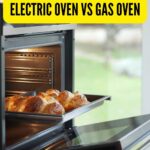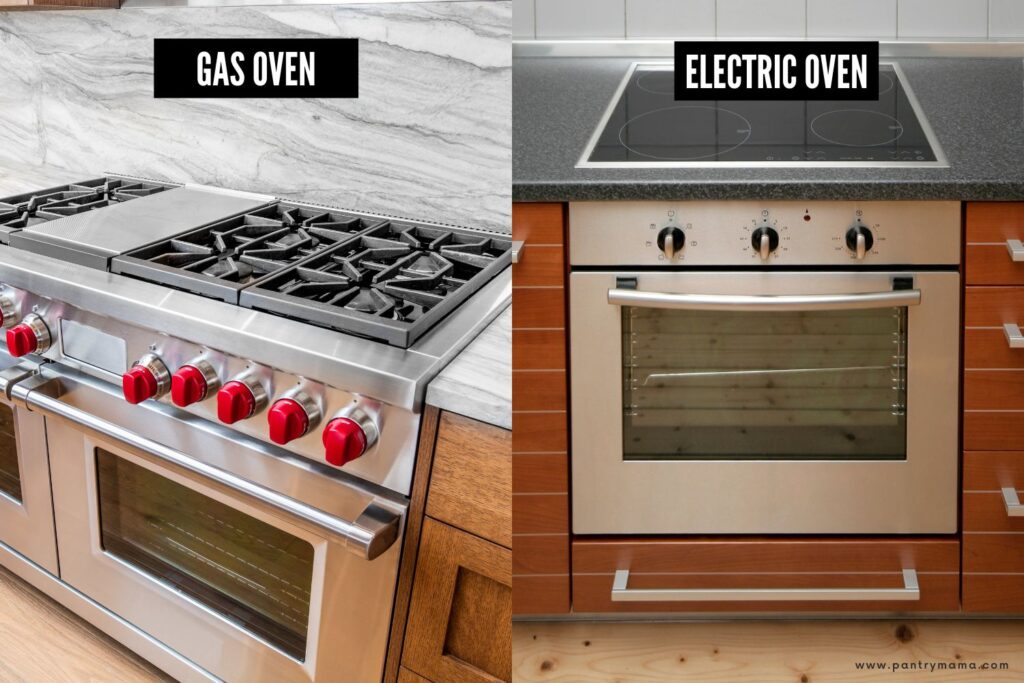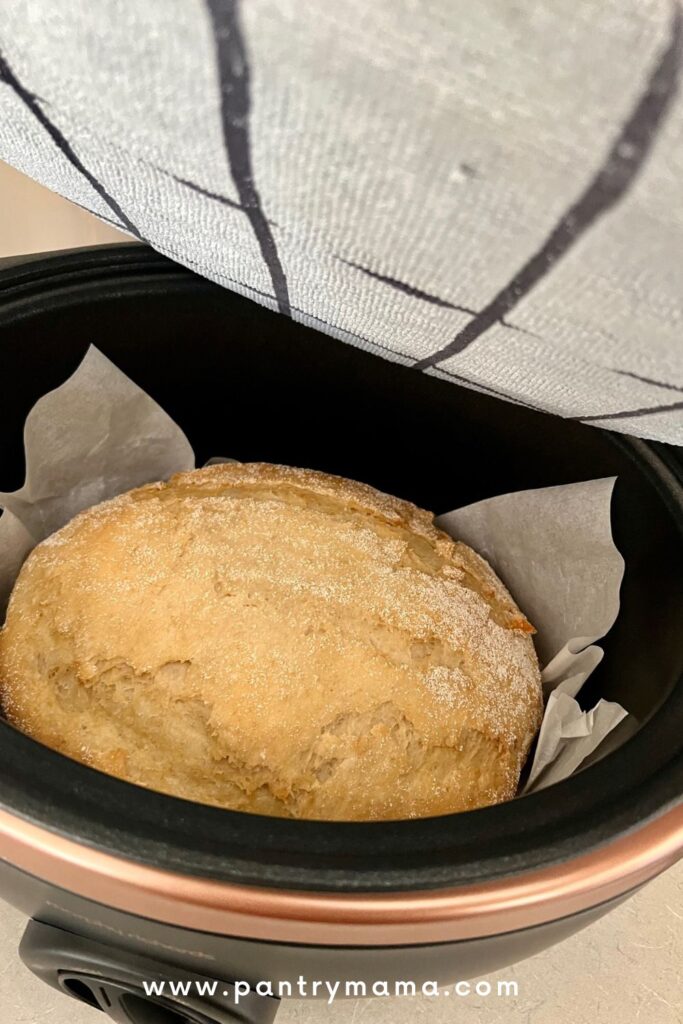Baking Bread In An Electric Oven VS Gas Oven


Is there really a difference in baking bread in an electric vs gas oven?
If you’re a bread baking lover like I am, when the time comes to get a new oven, there’s a lot to consider.
Is one oven better at baking bread than the other? Luckily for everyone involved, there isn’t actually a right or wrong answer.
It all depends on what you prefer and which characteristics speak to you more.
However, there are some key differences to take into consideration. If you want to buy a new oven, but don’t know where to start, stick around!
I’m going to be going through the key differences between gas and electric ovens.
There is always an argument for and against everything, so just remember that the choice is completely up to you in the end.
This post isn’t meant to be here to sway you in any way, only to enlighten you!
So, if you’re in the market for a new oven and want to make the right choice based on your needs, just keep reading.

Mục Lục
First Thing’s First, What If You Don’t Have An Oven At All?
I’d like to address this before we get into the numbers and everything else. If you are someone who currently has no oven to use, you could still do some baking in a toaster oven.
While doing this has its own challenges, it’s entirely possible. Of course, most people would prefer to have an oven at their disposal, but don’t let it stop you if you don’t currently have one. Did you know you can even bake sourdough in a toaster oven or a slow cooker?

The Differences Between An Electric And Gas Oven
If you’ve ever looked into buying an electric oven or gas oven, then you already know that they are both very different from each other.
They also come with their own advantages and disadvantages. So how does that affect our bread baking?
Well, as we’ll see in a bit, it doesn’t matter too much.
However, if you’re interested in getting a specific characteristic from either type of oven, then you should definitely check out what makes them unique.
The basic breakdown of the electric vs gas ovens will be bullet-pointed below:
Electric Oven
- Heat – The temperatures in the oven don’t drop at any point in the baking process, and you get an even bake.
- Temperature – Typically very accurate.
- Humidity – You get a dry, less humid heat from this oven which may require steam to be added for bread baking.
- Cost – Typically a lot more expensive, and you have the electric bill along with it.
Gas Oven
- Heat – The temperature in the oven is not even and there are hot and cold spots, making it more difficult to get an even bake.
- Temperature – Less reliable, and a separate thermometer is often relied upon.
- Humidity – You get a much more humid baking environment – this can be good for bread.
- Cost – Typically less expensive than electric ovens, and you have a cheaper gas bill.
GAS OVENELECTRIC OVENMOISTURE LEVELwetter, more humid heatdry heatTEMPERATUREless constant temperaturemore even temperaturePREHEAT TIMEfaster to preheat, quicker to cool downslower to preheat, slower to cool downCOST TO PURCHASEmore expensive to buyless expensive to buyCOST TO RUNcheaper to run, uses less fuelmore expensive to run, depending on electric prices.GOOD FOR ELEVATION?harder to run at elevationbetter option for elevation
The Breakdown
I’ll go through each of the differences mentioned above in detail so that you can get a better understanding of them.
Again, remember that there are no right or wrong options when it comes to oven choice!
Some people will love a characteristic that others hate, so you just need to pick what’s right for you in the end. It’s also a good idea to take into account the environment in which you live. Do you live at elevation and have a drier air or are you living at sea level where it’s more humid?
Okay, let’s take a look at what I mean by the bullet points above.
The Heat Difference
The Electric Oven
Electric ovens require preheating time. This means that the oven must be heated up before using it.
Once it reaches the proper temperature, you can start the cooking process. When you cook in an electric oven, the temperature stays constant throughout the entire baking cycle.
This is great because it ensures an even bake every single time. These ovens allow you to have good control over the heat inside, since these ovens typically come equipped with settings that allow you to adjust the heat level.
Baking bread in an electric oven is extremely easy because the temperature inside does not fluctuate.
The consistent heat in these devices is the opposite of that in gas ovens.
Consistent temperatures will result in a deliciously crisp crust and overall a delicious bread loaf.
Of course, with this high, consistent, temperature, you will need to pay attention so that the bread doesn’t burn – particularly on the base if you have dual elements.
The Gas Oven
Unlike electric ovens, gas ovens tend to heat up very quickly. That, however, is also paired with the oven having hot and cold spots in it.
However, if you’re looking for a quick way to make bread, then a gas oven might do the trick for you.
It won’t be as precise as an electric oven, but it will still work well and give you the results you desire.
In order to avoid half-golden bread in gas ovens, you will need to remember to rotate the bread.
You will need to expose all areas of the bread to the hotter spots in the oven to get an even bake.
This isn’t a dealbreaker for most people – it just makes you feel like you’re a few years behind everyone else!
It has a rustic feeling to it, which a lot of people enjoy! I can picture gas ovens in cute little traditional houses, rather than modern builds. They’re great!
The Temperature Difference
The Electric Oven
When it comes to temperature accuracy, electric ovens tend to be a lot more accurate. With a gas oven, you run the risk of burning things instead of baking them.
Electric ovens generally provide much greater precision than gas ovens do.
For example, you could use an electric oven to bake some delicious bread, you can trust the temperature dial within 5 degrees.
You will not experience temperature drops halfway through the bake with an electric oven.
This is due to how they operate. Electric ovens are usually regulated by heating elements (the ones used on some stoves) or thermistors.
Thermistors are basically a small electrical resistor that changes resistance when it heats up.
The amount of current passing through them is directly proportional to their temperature. This allows us to measure the actual temperature of our food.
So, overall, you can rely on the temperatures of electric ovens a lot more than gas ones.
I love electric ovens for this reason, as you won’t have to worry about your load being over done or underdone.
Chances are, if you can time it right, it’ll come out perfect!
The Gas Oven
Gas oven temperatures, on the other hand, are not nearly as accurate as electric ovens. These ovens heat up very fast, but do not have a stable temperature.
This means that the temperature can drop anywhere between 10 °F to 20 °F during the process of baking bread.
Because the temperature is constantly changing, you cannot rely on it to tell you whether your dough is ready or not.
To prevent your loaves from becoming dense or tough, you must keep track of the temperature of your dough throughout the entire process. This is why we use bread scales.
It is common to get an uneven bake when using gas ovens, so regular rotating is necessary.
Thermometers will be an extremely helpful tool when using gas ovens to bake bread with.
Also, you should always check the inside of your bread after 45 minutes of cooking and see if it’s browning correctly.
If it is not, you should remove it from the oven immediately and let it cool down completely before attempting again.
The Humidity Difference
The Electric Oven
The humidity in an electric oven is very low because there is no water vapor that is around due to the gas being ignited.
Electric ovens supply dry heat, making them perfect for baking and other tasks where moisture is not wanted.
This lack of moisture will help get bread crispy and delicious, rather than having a softer exterior.
If you want to add moisture in your electric oven, you can use something like a Dutch oven, which helps keep moisture inside.
Alternatively, you can also add a pan with some water and place it at the bottom of the oven, or even a water spritzer.
Some newer model electric ovens come with steam functions which can be perfect for the home bread baker, particularly if you love baking baguettes and sourdough.
However, your preferences might vary depending on what you’re making!
The Gas Oven
The best thing about a gas oven is the humid environment it makes from igniting the gas.
A humid environment is ideal for baking because it keeps moisture in the air while allowing steam to escape.
This type of environment makes it easier for the yeast to grow and multiply, creating bubbles and rising in the dough.
Many people love gas ovens specifically for their humidity, and who can blame them? I love them for that same reason.
No one wants a crust that is too hard, and using a gas oven is the perfect way to prevent that from happening.
The Cost Difference
The Electric Oven
Electric ovens can be pretty expensive, and can rack up an electric bill. However, they are often more efficient than other types of oven.
With that being said, however, since the energy market is forever changing, it is difficult to make a full assessment and predict prices.
The Gas Oven
The installation of a gas oven can be more expensive as many houses do not have gas points already available. It can be best to have a gas line installed while you’re building, but it can usually be done at any time with some work.
These ovens can be expensive, but they are thought to be more efficient because of their gas usage.
Sometimes, you might find that what you really want is a gas range with an electric oven – this can be a good compromise and is called a dual fuel option.
Need Some Tips For Baking In These Different Ovens?
Tips For Electric Oven Users
- Make use of foil – since electric ovens are known to dry out bread, you can use aluminum foil to combat this. Simply use foil to cover the bread loaf when it goes into the oven, and it shouldn’t over brown. Using foil will stop the top of the load from burning while allowing heat and air to circulate. It can also be used to trap steam.
- Use the middle shelf – the middle shelf of the electric oven is the best place for baking. This is because when you place bread here, it will get baked evenly, top, bottom, and around. You can also rotate the bread once to help with this, but it isn’t always necessary with an electric oven.
- Steam the bread – because these ovens have low humidity environments, it’s always recommended to add some humidity. You can do this by spraying some water in the oven, or fill a pan with water and place it at the bottom – plus some other ideas here. Both methods work well to make sure things don’t get too dry in the oven. You could also use a Dutch Oven when baking bread like sourdough to ensure that it gets adequate steam in a controlled environment.
- Use the correct bakeware – if you want your bread to brown on all sides, consider using a metal baking dish. Glass and other types of cookware have cooler surfaces, which mean that the browning process is slower. Metal bakeware will help you get the golden result we all want in our baking.
- Preheat the oven – since electric ovens take a little longer to heat up, it’s crucial to preheat them before baking. When you’re baking bread, the temperature needs to be correct as soon as the dough goes in. Allow the oven to take a few minutes to heat up before getting your dough in to bake. With bread like sourdough, pre heating the oven is crucial to having a searing hot oven to create the best oven spring when that dough hit the heat.
Tips For Gas Oven Users
- Rotate your bread – because gas ovens have hot and cold spots in it, you should try to rotate your bread at least twice while it bakes. Doing this will avoid one side from cooking too much and the other from cooking too little.
- Use bright-colored bakeware – dark colors absorb heat, and that’s what you want to avoid in a gas oven. Try using bright-colored bakeware that is made from silicone or glass. That way, the bottom and sides won’t burn like they would in metal or dark colors.
- Turn up the heat for crispy bread – the humidity will prevent your bread from crisping up unless you turn up the heat. Don’t be afraid to crank the heat up a little to achieve the crisp crust you want. A good 25 degrees Fahrenheit above the regular baking temperature will do the job, so don’t go crazy with it! Doing this will also cut the baking time by a few minutes, to always keep an eye on your loaf. It is generally better to turn up the heat towards the end of bread baking so that you’ve given the bread ample time to spring before the crust is formed.
- For an even bake, use a stone surface – by using a stone surface, you will help the heat get distributed more evenly when you bake. Baking stones will help you avoid the dreaded hot and cold spots you find in so many gas ovens.
What Oven Do I Bake Sourdough In?
Many of you will know me as a sourdough bread teacher and I absolutely love to bake sourdough day and night! You’ll find my tried and test sourdough recipe here.
I always bake my sourdough bread in an electric oven. I use a fan forced setting to ensure that the heat circulates quickly and evenly. I do however also use a Dutch Oven inside my electric oven to ensure that I create steam to give me a lovely crisp sourdough crust.
I am currently renovating my kitchen and will have 2 new ovens installed over the next month. These ovens will be electric steam ovens and I’m very excited to be able to talk to you about the difference having a steam oven will make on my bread baking!
Stay tuned for that!
Final Thoughts
In the end, the decision to go for a gas or electric oven is purely down to personal preference.
There are a lot of things to consider before taking the dive into your new oven.
I know it can be a difficult choice, but it’s always best to consider all the differences before you buy.
If you like something that makes you feel like a 21st century baking pro, the electric oven is a great choice.
If you like the feeling of baking bread in the 16th century, then the gas oven is the closest you can get without building a fire pit.
The gas ovens have a feel of authenticity and traditionalism about them, but that isn’t for everyone!
Hopefully this post has been helpful to you, and you now feel a little more equipped to make your decision.
Good luck finding your new favorite oven for baking that bread and sourdough!















![Toni Kroos là ai? [ sự thật về tiểu sử đầy đủ Toni Kroos ]](https://evbn.org/wp-content/uploads/New-Project-6635-1671934592.jpg)


